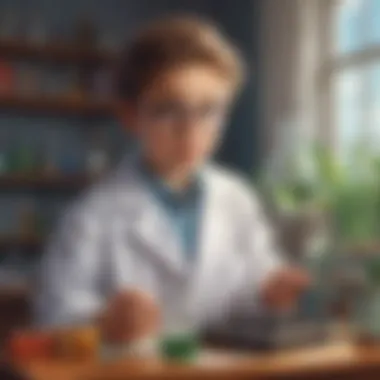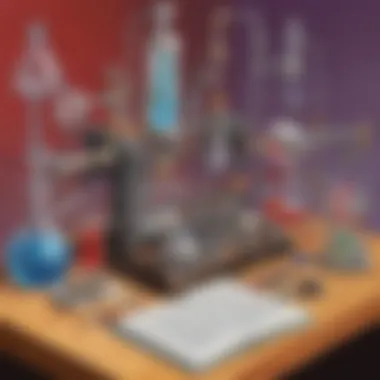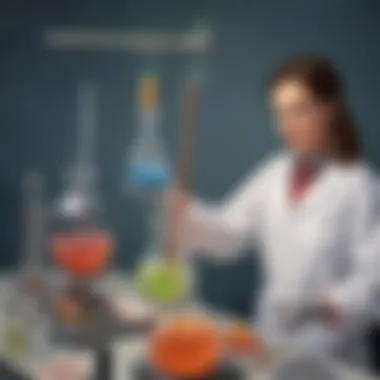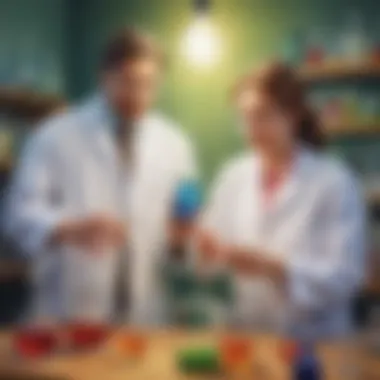Exploring Fascinating Science Experiments with Independent and Dependent Variables for Kids


Science Fun Facts
As we delve into the realm of easy science experiments that illuminate the concepts of independent and dependent variables, let's first spark our curiosity with some intriguing science facts. Did you know that water is the only substance on Earth that is found naturally in all three states - solid, liquid, and gas? This fascinating property of water plays a crucial role in several scientific experiments. Moreover, the Earth's atmosphere is composed of 78% nitrogen, 21% oxygen, and trace amounts of other gases, creating the perfect conditions for life as we know it.
Discover the Wonders of Science
In our journey to explore the wonders of science through engaging experiments, we aim to unravel various scientific concepts in a visually stimulating manner. Educational videos and animations serve as powerful tools to elucidate complex ideas, making learning more accessible and enjoyable for young minds. By connecting these concepts to real-life applications, we bridge the gap between theoretical knowledge and practical implementation, laying a solid foundation for a lifelong appreciation of scientific inquiry.
Science Experiment Showcase
Embark on a hands-on adventure filled with fun and engaging experiments that demonstrate the principles of independent and dependent variables. Each experiment is carefully crafted to provide step-by-step instructions for easy execution, accompanied by a comprehensive list of materials required. Safety tips and precautions are integrated seamlessly, ensuring a secure yet exciting learning environment for children aged 6-12. From observing chemical reactions to understanding the impact of variables on the outcome, these experiments promise to ignite a passion for science and foster a deeper understanding of scientific methods and principles.
Introduction
In this insightful article, we delve into the fascinating realm of easy science experiments focusing on independent and dependent variables. This journey is designed to captivate young minds between the ages of 6 to 12, providing an engaging and interactive way to understand fundamental scientific concepts. By exploring the relationship between variables through hands-on activities, children can nurture their curiosity and knowledge in the field of science.
Understanding Variables
Definition of Independent Variables
Embarking on our exploration, let's unravel the essence of independent variables. These variables stand as the factors intentionally manipulated or changed in an experiment to observe their effects on other variables. In the context of this article, independent variables play a crucial role in guiding the experiments, allowing young scientists to investigate how different elements influence outcomes. By comprehending the intricacies of independent variables, children can develop a structured approach to scientific inquiry, enhancing their analytical and problem-solving skills.
Definition of Dependent Variables
Next, we shine a light on dependent variables, which are the factors observed and measured based on the changes made to the independent variables. Dependent variables in these experiments reflect the outcomes or results affected by the variations in the independent variables. By grasping the significance of dependent variables, young learners can recognize the cause-and-effect relationships within experiments, fostering a deeper understanding of scientific processes. Through meticulous observation and measurement of dependent variables, children can draw meaningful conclusions and draw connections between different scientific phenomena.
Importance of Experimentation
Learning Through Hands-on Activities
As we delve deeper, we uncover the invaluable aspect of learning through hands-on activities. By engaging in these experiments, children are not merely passive observers but active participants in the scientific process. This hands-on approach enables students to apply theoretical knowledge practically, leading to a more profound comprehension of scientific principles. Through interaction with materials and equipment, young learners can nurture their creativity, critical thinking, and problem-solving abilities, laying a solid foundation for future scientific endeavors.
Developing Scientific Inquiry Skills
Moreover, we emphasize the critical role of developing scientific inquiry skills in young minds. Through experimentation, children are encouraged to ask questions, formulate hypotheses, and conduct investigations to find answers. This deliberate approach to scientific inquiry cultivates a sense of curiosity and exploration, empowering students to think analytically and logically. By honing their inquiry skills, children not only deepen their scientific understanding but also build essential skills for academic success and lifelong learning.
Experiment 1: Color Changing Flowers
In delving into the captivating world of science experiments focusing on independent and dependent variables, the significance of Experiment 1: Color Changing Flowers lies in its ability to illustrate these scientific concepts in a visually engaging and hands-on manner. This experiment not only entertains children aged 6-12 but also educates them on how different variables can impact outcomes, fostering a deeper understanding of scientific inquiry. By observing the color changes in flowers, young participants can grasp the relationship between the color of the food coloring (independent variable) and the resulting petal color change (dependent variable).
Materials Needed
White Flowers


White flowers play a crucial role in this experiment by serving as the subject of color transformation. Their white petals act as a canvas for the color-changing process, allowing children to witness a visible change when exposed to the dyed water. The simplicity and elegance of white flowers enhance the clarity of the color-changing effect, making them an ideal choice for demonstrating the impact of variables on an observable outcome.
Food Coloring
Food coloring serves as the agent of change in this experiment, allowing children to manipulate the independent variable by selecting different colors to observe the corresponding petal color changes. The vibrant hues of food coloring add excitement to the experiment, engaging young minds and encouraging them to explore how variations in the independent variable influence the dependent variable.
Water
Water acts as the medium through which the color transformation takes place. Its transparent nature enables children to witness the gradual shift in petal color as the flowers absorb the dyed water, providing a clear visual representation of the cause-and-effect relationship between the independent and dependent variables.
Vases
Vases serve as the containers for holding the white flowers and colored water during the experiment. Their role is not only functional but also aesthetic, enhancing the overall presentation of the color-changing flowers and creating a visually appealing setup for young scientists to conduct their observations.
Procedure
Adding Food Coloring to Water
The process of adding food coloring to water involves carefully selecting the desired colors and gently mixing them to achieve the desired intensity. Children can experiment with different color combinations to create unique solutions, exploring how varying the independent variable influences the subsequent petal color changes in the flowers.
Observing Color Changes in Flowers
Once the white flowers are placed in the colored water, children can observe and document the gradual color changes occurring in the petals. By closely monitoring the flowers over time, young scientists can note the progression of the color transformation, connecting the changes to the specific colors of food coloring used, thereby reinforcing the concept of independent and dependent variables.
Variables Identified
Independent Variable: Color of Food Coloring
The color of the food coloring represents the independent variable in this experiment, as it is deliberately chosen and manipulated by the participants to observe its impact on the petal color change. By exploring different color options, children can investigate how alterations in the independent variable lead to varying outcomes, thereby strengthening their grasp of experimental variables and their effects.
Dependent Variable: Petal Color Change
The petal color change serves as the dependent variable in this experiment, responding to the variations in the color of the food coloring. Through careful observation and documentation of the color changes in the flowers' petals, children can discern the direct relationship between the independent variable and the resulting dependent variable, gaining valuable insights into the scientific method and experimental design.
Experiment 2: Dancing Raisins
Experiment 2: Dancing Raisins holds a pivotal role in this article as it offers a fascinating exploration of scientific concepts to children aged 6-12. Through this experiment, young participants are introduced to the intriguing interaction between soda carbonation and the movement of raisins. This hands-on activity not only entertains but also educates, demonstrating the principles of independent and dependent variables in a clear and engaging manner. By observing the dynamic dance of raisins in soda, children gain a deeper understanding of how changing one variable can impact another, fostering curiosity and critical thinking skills.
Materials Needed
Clear Soda
Clear soda plays a fundamental role in the Dancing Raisins experiment, serving as the primary medium through which the fascinating display of raisin movement occurs. The transparency and carbonation of clear soda are crucial features that enable visual observation of the interaction between the soda and the raisins. The effervescence of the soda provides buoyancy to the raisins, creating an exciting visual effect that captivates young minds and enhances the overall learning experience.
Raisins


Raisins are essential components of the Dancing Raisins experiment, showcasing a practical example of an object's response to changes in its environment. The wrinkled surface of the raisins allows them to trap gas bubbles released by the soda, leading to their characteristic 'dancing' motion. This simple yet captivating phenomenon illustrates the concept of a dependent variable, as the movement of the raisins is directly influenced by the carbonation level of the soda.
Glass
The glass container used in the experiment serves as a controlled environment where the interaction between the raisins and clear soda can be easily observed. Its transparent structure allows participants to witness the fascinating dance of the raisins firsthand, promoting engagement and facilitating scientific inquiry. The glass container's stability and clarity ensure that the experiment proceeds smoothly and that accurate observations can be made throughout.
Timer
A timer is a valuable tool in the Dancing Raisins experiment, enabling participants to record and measure the duration of the raisins' movement in the clear soda. By timing how long the raisins 'dance' within the soda, young scientists can gather quantitative data related to the experiment. The timer adds a dimension of precision to the activity, encouraging children to approach scientific investigations with attention to detail and accuracy.
Procedure
Dropping Raisins in Soda
The act of dropping raisins into the clear soda initiates the captivating display of movement that defines the Dancing Raisins experiment. As the raisins interact with the carbonated liquid, gas bubbles adhere to their wrinkled surfaces, causing them to rise and fall rhythmically. This mesmerizing phenomenon showcases the influence of the soda's carbonation on the raisins' behavior, illustrating the concept of a dependent variable in a tangible and memorable way.
Observing Raisins' Movement
Observing the movement of raisins within the clear soda allows participants to witness firsthand the impact of soda carbonation on the raisins' buoyancy and motion. By closely monitoring and documenting the raisins' behavior over time, children can draw connections between the variables at play in the experiment. This observational aspect encourages critical thinking and scientific reasoning, empowering young learners to make insightful conclusions based on their findings.
Variables Identified
Independent Variable: Soda Carbonation
Soda carbonation serves as the independent variable in the Dancing Raisins experiment, representing the factor that is deliberately changed or manipulated by the participants. By varying the level of carbonation in the clear soda, children can observe how this independent variable influences the behavior and movement of the raisins. This dynamic relationship between the soda's carbonation and the raisins' response provides a hands-on illustration of scientific principles and encourages experimentation and inquiry.
Dependent Variable: Raisins' Movement
The movement of the raisins in the clear soda acts as the dependent variable in the experiment, responding to changes in the independent variable of soda carbonation. The observable dance of the raisins serves as a direct outcome of the carbon dioxide bubbles released in the soda and highlights the cause-and-effect relationship between variables. By focusing on the dependent variable of raisins' movement, young scientists can draw connections between experimental inputs and observed outcomes, strengthening their understanding of scientific inquiry and experimental design.
Experiment 3: Growing Crystals
Experiment 3 in this article focuses on the enthralling process of growing crystals, a fascinating scientific endeavor. Understanding the crystallization process is crucial as it allows kids aged 6-12 to witness firsthand how substances transform from liquid to solid state, unveiling the beauty of crystal formation. This experiment not only captivates young minds but also instills a sense of wonder and curiosity about the natural world, fostering a keen interest in chemistry and scientific phenomena.
Materials Needed
Borax Powder
Borax powder plays a pivotal role in this experiment, serving as the key ingredient for creating the crystal-growing solution. Borax, a white crystalline compound, boasts excellent solubility in water, making it an ideal choice for crystal formation experiments. Its unique characteristic lies in its ability to form intricate crystal structures when dissolved in hot water, providing a mesmerizing visual representation of crystallization. The advantages of using borax powder include its affordability, accessibility, and non-toxic nature, ensuring a safe and engaging scientific experience for young learners.
Boiling Water
Boiling water is an essential component in this experiment, as it serves as the solvent for dissolving the borax powder. The key characteristic of boiling water is its high temperature, which facilitates the rapid dissolution of borax, enabling the formation of a saturated solution conducive to crystal growth. The advantage of using boiling water lies in its efficiency in creating a concentrated borax solution quickly, ensuring optimal conditions for crystal formation.
Jar


A jar is required to hold the borax solution and facilitate the crystal growth process. The key characteristic of the jar is its transparency, allowing young scientists to observe the crystal growth progression clearly. Jars are popular choices for crystal growing experiments due to their ample size, which accommodates the formation of multiple crystals simultaneously. The unique feature of jars is their versatility, enabling various crystal growing methods and experimental variations.
Pipe Cleaners
Pipe cleaners serve as the base for crystal growth in this experiment, acting as the scaffold for crystal formation. The key characteristic of pipe cleaners is their porous and absorbent nature, which allows them to attract and hold onto the crystallizing borax solution effectively. Pipe cleaners are a popular choice for crystal growing activities due to their flexibility and ease of manipulation, making them ideal for creating customized crystal shapes. The unique feature of pipe cleaners is their ability to create colorful and intricate crystal formations, adding a creative element to the experiment.
Procedure
Creating Borax Solution
The first step in this experiment involves creating a saturated borax solution by dissolving borax powder in boiling water. The key characteristic of this process is the careful measurement of borax powder to water ratio to achieve the desired concentration for crystal growth. Creating the borax solution is a critical stage that sets the foundation for successful crystal formation, emphasizing the importance of precision and consistency in scientific experimentation. The advantage of this step is the hands-on experience it provides in preparing chemical solutions, enhancing scientific literacy and laboratory skills in young learners.
Growing Crystals on Pipe Cleaners
Once the borax solution is prepared, the next step is to immerse the pipe cleaners in the solution and allow them to absorb the liquid. Over time, the borax particles adhere to the surface of the pipe cleaners, gradually crystallizing to form intricate crystal structures. The key characteristic of this process is the gradual crystal growth observed on the pipe cleaners, showcasing the progression from a liquid solution to solid crystal formations. Growing crystals on pipe cleaners is a visually captivating activity that highlights the concept of nucleation and crystal lattice formation, promoting a deeper understanding of crystal growth principles. The advantage of this step is the interactive nature of observing crystals evolve, stimulating curiosity and scientific inquiry among young experimenters.
Variables Identified
Independent Variable: Borax Concentration
The independent variable in this experiment is the concentration of borax in the crystal-growing solution. By varying the amount of borax powder dissolved in boiling water, young scientists can explore the impact of borax concentration on crystal size, shape, and growth rate. The key characteristic of the independent variable is its direct influence on crystal formation, allowing for controlled experimentation to investigate the relationship between borax concentration and crystal growth. Exploring different borax concentrations offers insights into crystal formation processes and chemical solubility, enriching young minds with foundational chemistry principles. The advantage of manipulating borax concentration as an independent variable is the hands-on exploration of solution saturation and its effects on crystal morphology, fostering critical thinking and hypothesis testing skills.
Dependent Variable: Crystal Growth
The dependent variable in this experiment is the growth of crystals on the pipe cleaners submerged in the borax solution. Crystal growth serves as a visual indicator of the effectiveness of the crystal-growing process, demonstrating how the controlled variables influence the formation of crystal structures. The key characteristic of the dependent variable is its responsiveness to changes in borax concentration, temperature, and time, reflecting the observed outcomes of the experiment. Monitoring crystal growth allows young scientists to track the progression of crystal formation, emphasizing the interconnectedness between independent variables and crystal growth patterns. The advantage of tracking crystal growth as a dependent variable is the practical application of scientific observation and data collection, enhancing analytical skills and attention to detail in budding researchers.
Conclusion
In the pursuit of scientific knowledge, the conclusion serves as a pivotal point to draw together all aspects explored in this article - the significance of independent and dependent variables in easy science experiments. Understanding this fundamental concept opens doors to a deeper comprehension of how variables interact in scientific investigations. By reflecting on the experiments detailed in this piece, young learners can grasp the essence of experimental design and the critical role of variables.
The Conclusion segment acts as a bridge between theory and practice, urging children to apply their newfound knowledge in various scenarios. It instills a sense of curiosity and analytical thinking, nurturing a scientific mindset essential for their academic and personal growth. Delving into this section, readers will discern the practical implications of manipulating variables in experiments and appreciate the impact of their observations.
Encouraging a spirit of inquiry, the Conclusion section reinforces the idea that learning is a continuous process. It underscores the importance of experimentation as a pathway to discovery and encourages children to embrace challenges and uncertainties in their quest for scientific understanding.
Reflecting on Learning
Real-world Applications of Variables
Real-world applications of variables extend far beyond the confines of a science experiment, offering tangible connections to everyday phenomena. In this context, understanding how independent and dependent variables operate equips young learners with a powerful tool to analyze causality and relationships. By demonstrating these concepts through engaging experiments, children can apply this knowledge to scenarios outside the classroom.
The focal point of real-world applications lies in cultivating critical thinking skills and fostering a curious mindset. It empowers children to make informed decisions, solve problems methodically, and approach challenges with a structured approach gleaned from their scientific explorations. The practical aspect of variables in real-world scenarios enhances a child's ability to navigate complexities and make sense of the world around them.
Moreover, by emphasizing real-world applications in the realm of variables, this article underscores the relevance of scientific principles in diverse fields. Whether in technology, environmental studies, or healthcare, the meticulous understanding of variables plays a crucial role in driving innovation and progress.
Encouraging Further Exploration
Encouraging further exploration serves as a catalyst for continuous learning and intellectual growth. By nurturing a spirit of curiosity and discovery, this aspect propels children towards new avenues of understanding and exploration. It ignites a passion for discovery and cultivates a sense of wonder that propels learners to delve deeper into the realms of science.
The key characteristic of encouraging further exploration lies in its ability to spark creativity and innovation. It prompts children to push boundaries, ask probing questions, and seek answers through experimentation and analysis. This active engagement with the learning process fosters resilience and adaptability, essential qualities for success in both academic and real-world settings.
Furthermore, by highlighting the unique feature of encouraging further exploration, children are empowered to think critically, communicate their findings effectively, and collaborate with peers to enrich their learning journey. It fosters a supportive environment where curiosity thrives, leading to personal growth and a lifelong passion for learning.







